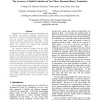Free Online Productivity Tools
i2Speak
i2Symbol
i2OCR
iTex2Img
iWeb2Print
iWeb2Shot
i2Type
iPdf2Split
iPdf2Merge
i2Bopomofo
i2Arabic
i2Style
i2Image
i2PDF
iLatex2Rtf
Sci2ools
CGO
2004
IEEE
2004
IEEE
The Accuracy of Initial Prediction in Two-Phase Dynamic Binary Translators
Dynamic binary translators use a two-phase approach to identify and optimize frequently executed code dynamically. In the first step (profiling phase), blocks of code are interpreted or quickly translated to collect execution frequency information for the blocks. In the second phase (optimization phase), frequently executed blocks are grouped into regions and advanced optimizations are applied on them. This approach implicitly assumes that the initial profile of each block is representative of the block throughout its lifetime. This study investigates the ability of the initial profile to predict the average program behavior. We compare the predicted behavior of varying lengths of the initial execution with the average program behavior for the whole program execution, and use the prediction from the training input as the reference. Our result indicates that, for the SPEC2000 benchmarks, even very short initial profiles have comparable prediction accuracy to the traditional profile-gui...
Average Program Behavior | CGO 2004 | Dynamic Binary Translators | Initial Profile | Software Engineering |
| Added | 20 Aug 2010 |
| Updated | 20 Aug 2010 |
| Type | Conference |
| Year | 2004 |
| Where | CGO |
| Authors | Youfeng Wu, Mauricio Breternitz Jr., Justin Quek, Orna Etzion, Jesse Fang |
Comments (0)

